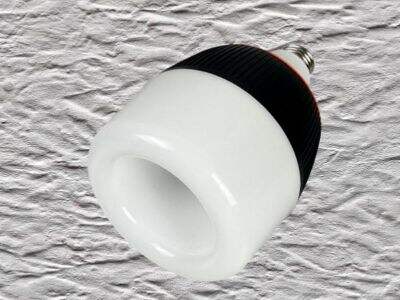Salom, yosh o'qovchilar. LED lampa haqida afzalliklar va kamchiliklaringiz haqida eshitgansizmi? Ular haqida uyda, maktabda yoki ko'pchiligi bilan taniqli do'konlarda ekranlarda uchrashgan bo'lishingiz mumkin. Ammo ularning nimadirini qanchalik yaxshi bilasiz va nima sababli xususiyatlari borligini? LED lampalar Hulang standart lampalardan farqli energiya va pul saqlashga yordam beruvchi ishlatiladi. Ularning oshib chiqishidan qarama-qarshi, ular haqida ko'p xatolarga ega bo'lishimiz mumkin. Bugun biz ushbu xatolarni to'g'irlaymiz va eng mashhur LED yoritgichlarining noto'g'ri fikrlarini tozalaymiz.
LED lampalar haqida haqiqat
Xatolik 1: LED lampalar qimmat.
Миф: LED лампочкалари традиционал лампочкалардан кўп пул сарф этади. LED лампочкалар сони олиш учун биринчи маротабада котара махсус қиймат бор бўлиши мумкин, лекин улар 25,000 соатгача ишлаши мумкин бўлган узун дастлабкийотга эга бўлади. Бу ески турдаги лампочкалардан 20 дахил юрт таьрифига эга. Тасаввур килинг, сиз янги лампочкани яна-яна сонишингиз шарт bo'lmaydi. Нихоё ваqtда, ундан кейин сиз янги лампочкаларни бир неча мarta сонишингиз шарт бўлмайди ва ундан кейин сиз уларда котара пул сарф этмасангиз хам, улар биринчи маротабада котара қийматли деб чиқишади.
Миф 2: LED лампочкалари жуда чучук.
LED лампочкалари чучукligi чора бир миф. Аммо ҳақиқат ушбу e27 led lampochka бирор вақтда яримликлари бўлмаган. Улар кушма-кушма свет чиқариш мумкин, луменларда изобда бўлган, андишма-андишли электрик лампочкалардан котара, унда камироқ энергия фойдаланилади. Бу сиз учинча, юксак электрик егоҳ битса да, хоналaringizни яримлаштириш мумкин. Шунинг учун, агар сиз кучли свет керак бўлса, LED лампочкалари ушбу масалаларни ўзгартиришда муваффақиятга эга.
Миф 3: LED лампочкалари экологик нозик эмас.
Bazi odamlar LED lampalarining dunyoning uchraydigan joylariga zarar berishi shu sababli ular ichida qotiq narsalar borligini o'ylaydi. Ammo bu to'g'ri emas. Klassik lampalarga nisbatan, LED lampalarida ko'proq zararli materiallar yo'q. Haqiqatan ham, LED lampalar qayta ishlash mumkin bo'ladi, shuning uchun ularni o'tkazib yubormasdan, qayta ishlatish orqali dunyoga yordam berishingiz mumkin va uni solvetsiz saxlashingiz mumkin. Bu esa nimadir LED lampalarining ekologiyani saqlashda yaxshi tanlov bo'lishini ta'minlaydi.
lED Lampalar haqida 6 Mit — Tozalandi.
Mit#1: LED lampalari ko'zlarimizni yoritadi chunki uning ichida mavi yorug'lik chiqadi.
Bazi odamlar debdi ki LED Lampa mavi yorug'lik chiqaradi, bu ko'zlarimizni zayiflashtirishi mumkin. Ammo haqiqat budki, LED lampalar oq yorug'lik chiqaradi va siz uni yorug'ligini yoki yumshaqchasini boshqarishingiz mumkin.” Bu esa, xonangizda qanday turdagi yorug'lik istaysiz uni tanlash imkoniyatingizni anglatadi. Shuning ochiq, LED kengaytirilgan yorug'likni ishlab chiqarmaydi, shuning uchun bu ko'zlar uchun yaxshi. Nimaga bu muhim: Biz o'qish yoki hattakisi uy vazifasi qilishda ko'zlarimizning yomonlanmasligini istamaymiz.
MITH 2: LED lampochkalar o'rniga yuzingizni sababli bo'lgan ishik chiqaradi.
Masalan, ba'zi odamlar LED lampochkalarining sababli ishik chiqarishi va bu ko'z tashqarisiga zarar berishi kerakligini o'ylaydi. Ammo u haqiqat emas. LED ishiklar hech qachon zararli ultratartibli (UV) ishikni chiqarmaydi. Buning o'rnida ular juda kam issiqlik yaratadi, bu esa ularni qo'shma-ko'rsatma bilan sog'lom turish va foydalanish uchun xavfsiz qiladi. Demak, LED lampochkasini yoqgan holda o'zining urinib ketmaslikdan qotqirmangiz kerak.
Myth 3: LED lampochkalar yoqimli emas.
Ba'zi odamlar konvetsional lampochkalarni kabi LED lampochkalarini yoqimli holatda ishlatib bo'lmaydi deb o'ylaydi. Ammo bu noto'g'ri fikr. Haqiqatda, eski inkandetsent lampochkalarga o'xshab, LED lampochkalar ham yoqimli bo'lishi mumkin. Aslida, sizning LED lampochkanigiz paketda 'yoqimli' deb belgilangan bo'lishi kerak. Bu esa sizni Esqm xonalari uchun hamma narsa uchun - ya'ni, o'qish, o'yin o'ynash yoki dam olmoqchisi - ideal ishik sozlashga imkon beradi.
LED ishikchilarining tomonidan muvozanatlangan eng ko'p mitlar bor.
Xalf 1: LED lampochkalar faqat Xitoyda ishlab chiqariladi.
Ko'p kishi barcha LED lampochkalarining Xitoyda ishlab chiqarilganini o'ylaydi. Ammo, bu haqiqat emas. Haqiqatan, ko'p LED lampochkalar Birlashgan Davlatlar, Yaponiya va Gʻanada kabi boshqa mamlakatlarda ishlab chiqariladi. Demak, dunyoning ko'plab joylari LED lampochkalarini ishlab chiqaradi.
Xalf 2: LED lampochkalar dimmer peremeklar bilan ishlamaydi.
Ko'p kishi LED lampochkalarning, foydalanuvchi uchun yorliqlarni darajasini sozlamasligi mumkin bo'lgan dimmer peremeklar bilan uyumli emasligiga ishonadilar. Lekin bu xalf. LED lampochkalar dimmer peremekka qadar kamaytirilishi mumkin, lekin sizning LED lampochkanigiz dimmeringiz bilan uyumli ekanligiga ishonchingiz bo'lishi kerak. Agar shunday bo'lsa, siz oddiy ravishda yorliqni hayot yo'riqiningiz yoki faoliyatga qarab tartiblashishingiz mumkin.
Xalf 3: LED lampochkalardan issiq chiqmaydi.
Бирор даҳилар LED лампALAR ҳеч қандай жиёри ёчиб бермайдиган ва шу учун қишда уйларимизни исқо топишга ёмгир эмас деб ойладилар. Лекин бу имконийат тўлиқ рост эмас. Уларда 5 watt li LED lampa жиёри ёчилади, лекин ушбу жиёр инцандесцент ва флуоресцент лампалардан кўпча кам. Бу ушбу лампаларнинг ёрдамида уйингизни исқо топишингиз мумкин, лекин қулай бўlish учун бир нечта лампа ўрнатишингиз керак.
LED lampalar haqida haqiqat
Шунингдек, ҳисоблаш натижаси сифатida, LED лампALAR барча нуқтада янгиликлар: улар энергия яхшилигини хам йиғилишини хам сақлайди ва сизни ақиллироқ кўради. Улар ярғон ва 25,000 соатга тушунчалик дейилади, лекин уларда камида хомсиз материаллар бор ва уларни тамомланганidan keyin ривожлантириш мумкин, шу учун улар планетамиз учун дустликка эга. Улар юксак белгилари бўйича ўзгартиришингиз мумкин ва улар ҳар бир вақтда ўзгаришга туғри келади. Кўпча LED лампALAR ҳар бир давлатда ишlab чиқилган ва диммер тугмаларида ишлатиши мумкин.
Shuningdek, LED-lampochkalarning uchun chiroyli xulqatlarining bir qismini yurchamizdan tomonidan tozalanganligiga ishonch hosil qilishga yordam berishimizni umid qilamiz. Endi siz LED-lampochkalar siz va dunyo uchun tog'ri ekanligiga ishonishingiz mumkin. Faqat unutmangki, energiya, pul va dunyoning saqlanishini ta'minlaydigan LED-lampochkalar tanlaganingiz uchun zekiy narsa qilasiz.
 EN
EN
 AR
AR
 HI
HI
 PT
PT
 RU
RU
 ES
ES
 TL
TL
 ID
ID
 VI
VI
 TH
TH
 TR
TR
 FA
FA
 AF
AF
 MS
MS
 HY
HY
 AZ
AZ
 KA
KA
 HT
HT
 CEB
CEB
 EO
EO
 HA
HA
 IG
IG
 JW
JW
 KM
KM
 LO
LO
 LA
LA
 MR
MR
 NE
NE
 SO
SO
 YO
YO
 ZU
ZU
 MY
MY
 NY
NY
 KK
KK
 SI
SI
 ST
ST
 SU
SU
 TG
TG
 UZ
UZ
 AM
AM

